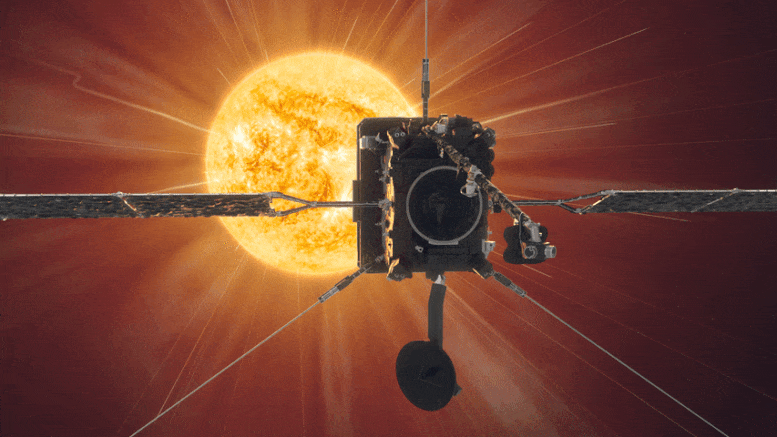

Animation des Solar Orbiter der Europäischen Weltraumorganisation. Bildnachweis: ESA / Medialab
Die neuesten Solar Orbiter-Bilder zeigen die volle Sonne in beispielloser Detailtreue. Es wurde am 7. März 2022 aufgenommen, als das Raumschiff direkt zwischen Erde und Sonne hin- und herflog.
Eines der vom Extreme Ultraviolet Imager (EUI) aufgenommenen Bilder ist das höchstaufgelöste Bild der gesamten Sonnenscheibe und der äußeren Atmosphäre, der Korona, das jemals aufgenommen wurde.
Ein weiteres Bild, das vom Spectral Imaging of the Coronal Environment (SPICE)-Instrument aufgenommen wurde, stellt das erste vollständige Bild der Sonne seit 50 Jahren dar und das beste Bild, das entlang der Lyman-Beta-Wellenlänge der von Wasserstoffgas emittierten ultravioletten Strahlung aufgenommen wurde.
Die Bilder wurden aufgenommen, als der Solar Orbiter etwa 75 Millionen Kilometer entfernt war, auf halbem Weg zwischen unserer Erde und seinem Mutterstern. Das hochauflösende Teleskop des EUI nimmt Bilder mit einer so hohen räumlichen Auflösung auf, dass in dieser geringen Entfernung ein Mosaik aus 25 Einzelbildern benötigt wird, um die gesamte Sonne abzudecken. Das vollständige Bild wurde einzeln aufgenommen und über einen Zeitraum von über vier Stunden aufgenommen, da jedes Teil etwa 10 Minuten dauert, einschließlich der Zeit, die das Raumschiff benötigt, um von einem Teil zum nächsten zu zeigen.
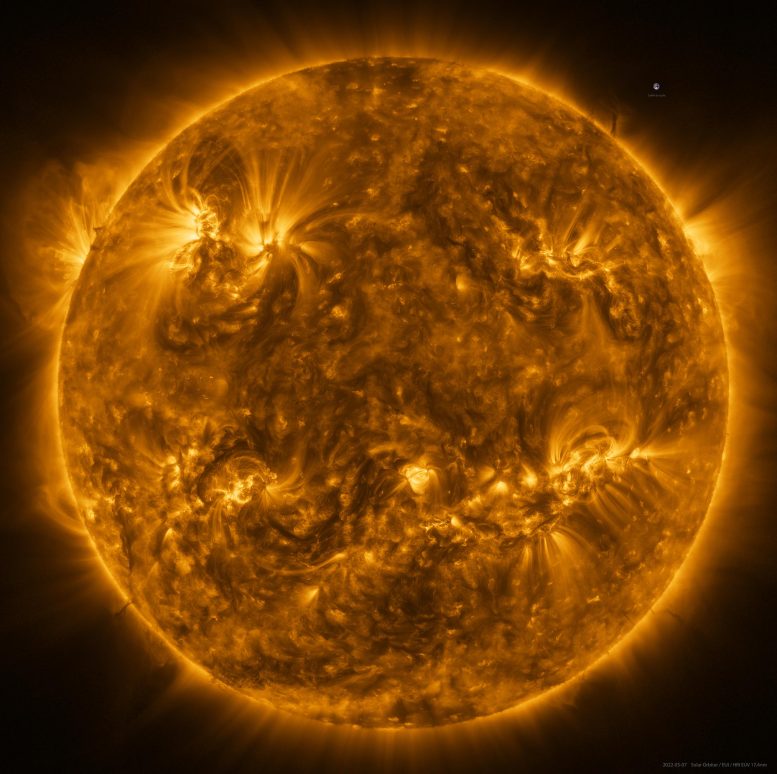
Die Sonne, wie sie vom Solar Orbiter in extrem ultraviolettem Licht aus einer Entfernung von etwa 75 Millionen km gesehen wird. Das Bild ist ein Mosaik aus 25 Einzelbildern, die am 7. März 2022 vom Ultraviolet Imaging Instrument (EUI) High Resolution Telescope aufgenommen wurden. Dieses Bild wurde bei einer Wellenlänge von 17 Nanometern im extremen Ultraviolettbereich des elektromagnetischen Spektrums aufgenommen und zeigt die obere Atmosphäre der Sonne, die Korona, die eine Temperatur von etwa einer Million Grad Celsius hat. Ein Erdbild der Skala an der 2-Uhr-Position ist ebenfalls enthalten Bildnachweis: ESA und NASA/Solar Orbiter/EUI-Team; Datenverarbeitung: E. Kraaikamp (ROB)
Insgesamt die endgültiges Bild Es enthält mehr als 83 Millionen Pixel in einem Raster von 9148 x 9112 Pixeln. Zum Vergleich: Dieses Bild hat eine zehnmal bessere Auflösung als ein 4K-Fernsehbildschirm anzeigen kann.
EUI zeigt die Sonne bei einer Wellenlänge von 17 Nanometern im extremen Ultraviolettbereich des elektromagnetischen Spektrums. Dies zeigt die obere Atmosphäre der Sonne, die Korona, die eine Temperatur von etwa einer Million Grad hat[{“ attribute=““>Celsius.
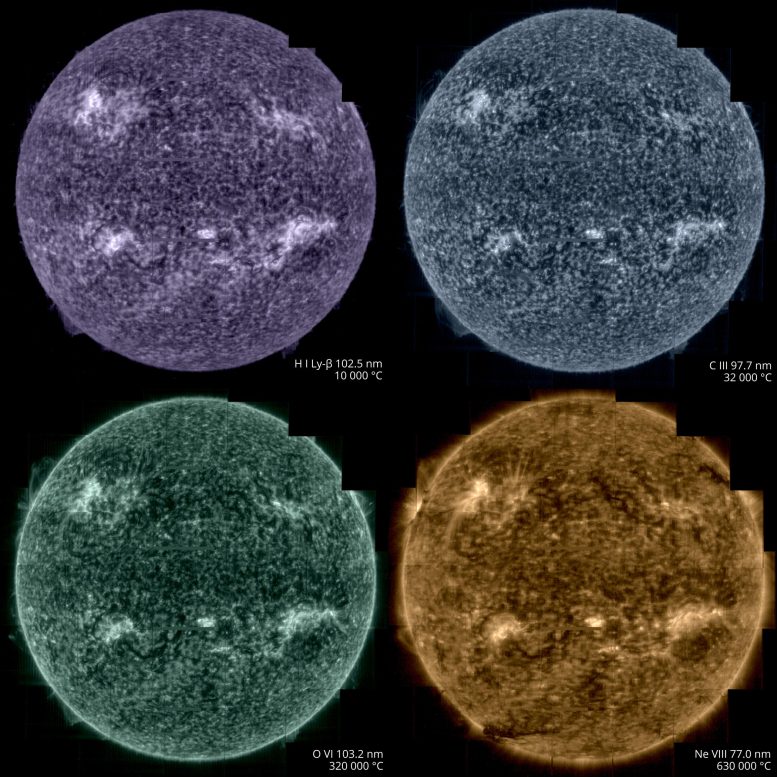
Solar Orbiter took images of the Sun on March 7, from a distance of roughly 75 million kilometres, using its Spectral Imaging of the Coronal Environment (SPICE) instrument. SPICE takes simultaneous “spectral images” at several different wavelengths of the extreme ultraviolet spectrum by scanning its spectrometer slit across a region on the Sun. The different wavelengths recorded correspond to different layers in the Sun’s lower atmosphere. Purple corresponds to hydrogen gas at a temperature of 10,000°C, blue to carbon at 32,000°C, green to oxygen at 320,000°C, yellow to neon at 630,000°C. Each full-Sun image is made up of a mosaic of 25 individual scans. It represents the best full Sun image taken at the Lyman beta wavelength of ultraviolet light that is emitted by hydrogen gas. Credit: ESA & NASA/Solar Orbiter/SPICE team; Data processing: G. Pelouze (IAS)
At the 2 o’clock (near the image of the Earth for scale) and 8 o’clock positions on the edges of the Sun, dark filaments can be seen projecting away from the surface. These ‘prominences’ are prone to erupt, throwing huge quantities of coronal gas into space and creating ‘space weather’ storms.
In addition to EUI, the SPICE instrument was also recording data during the crossing. These too needed to be pieced together as a mosaic.
SPICE is designed to trace the layers in the Sun’s atmosphere from the corona, down to a layer known as the chromosphere, getting closer to the surface. The instrument does this by looking at the different wavelengths of extreme ultraviolet light that come from different atoms.
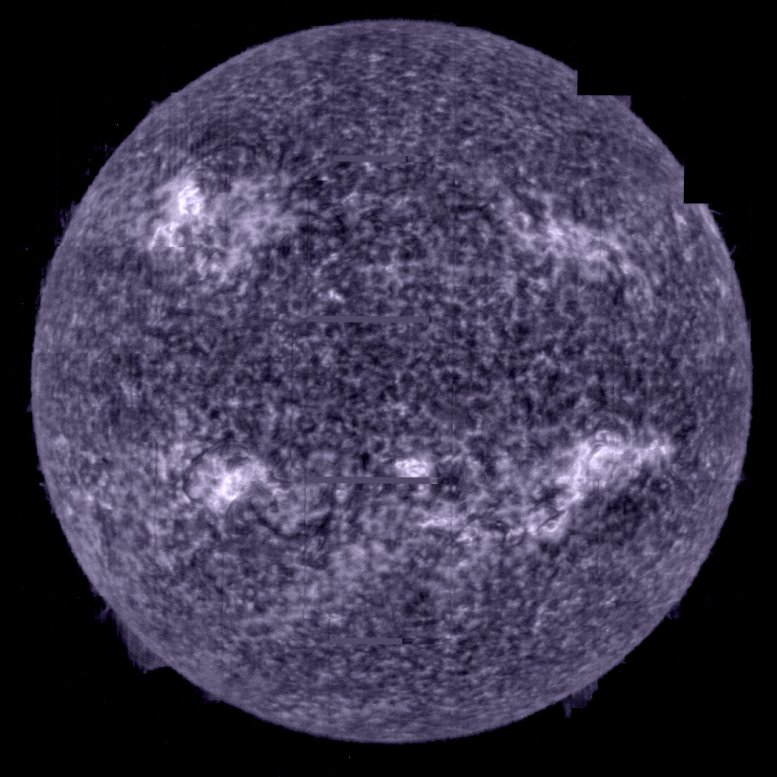
Taking the Sun’s temperature. Credit: ESA & NASA/Solar Orbiter/SPICE team; Data processing: G. Pelouze (IAS)
In the SPICE sequence of images purple corresponds to hydrogen gas at a temperature of 10,000°C, blue to carbon at 32,000°C, green to oxygen at 320,000°C, yellow to neon at 630,000°C.
This will allow solar physicists to trace the extraordinarily powerful eruptions that take place in the corona down through the lower atmospheric layers. It will also allow them to study one of the most puzzling observations about the Sun: how the temperature is rising through the ascending atmospheric layers.
Usually the temperature drops as you move away from a hot object. But above the Sun, the corona reaches a million degrees Celsius whereas the surface is only about 5000°C. Investigating this mystery is one of the key scientific objectives of Solar Orbiter.
The images were taken on 7 March, precisely when Solar Orbiter crossed the Sun-Earth line, so the images can be compared with Earth-bound solar instruments and cross-calibrated. This will make it easier to compare results from different instruments and observatories in future.
On March 26, Solar Orbiter reaches another mission milestone: its first close perihelion. The spacecraft is now inside the orbit of Mercury, the inner planet, taking the highest resolution images of the Sun it can take. It is also recording data on the solar wind of particles that flows outwards from the Sun.
And this is just the start, over the coming years the spacecraft will repeatedly fly this close to the Sun. It will also gradually raise its orientation to view the Sun’s previously unobserved polar regions.
Solar Orbiter is a space mission of international collaboration between ESA and NASA.

„Zertifizierter Unruhestifter. Freundlicher Forscher. Web-Freak. Allgemeiner Bierexperte. Freiberuflicher Student.“

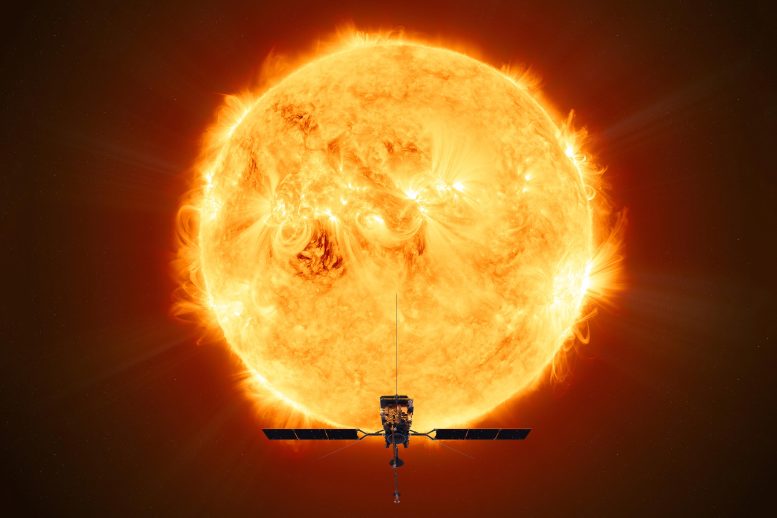




More Stories
Die Federal Aviation Administration fordert eine Untersuchung des Misserfolgs bei der Landung der Falcon-9-Rakete von SpaceX
Identische Dinosaurier-Fußabdrücke auf zwei Kontinenten entdeckt
SpaceX startet 21 Starlink-Satelliten mit einer Falcon 9-Rakete von Cape Canaveral aus – SpaceflightNow